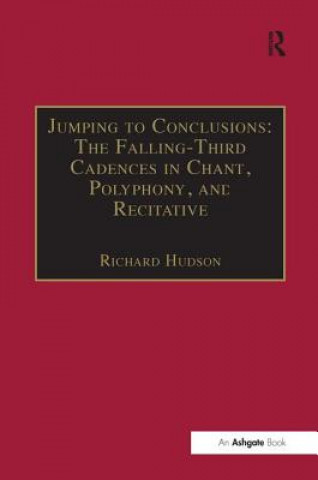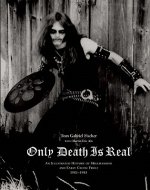
Kód: 04680079
Jumping to Conclusions: The Falling-Third Cadences in Chant, Polyphony, and Recitative
Autor Richard Hudson
This book concerns the cadences which reach their conclusion by jumping from scale degree 3 down to 1 or to 1-7-1. The chronological history commences in Gregorian Chant, where the falling third is often preceded by scale degree 4 ... celý popis
- Jazyk:
 Angličtina
Angličtina - Vazba: Pevná
- Počet stran: 224
Nakladatelství: Taylor & Francis Ltd, 2005
- Více informací o knize

Mohlo by se vám také líbit
-

Belief in Media
4798 Kč -

Peerless Four
437 Kč
Dárkový poukaz: Radost zaručena
- Darujte poukaz v libovolné hodnotě a my se postaráme o zbytek.
- Poukaz se vztahuje na celou naši nabídku.
- Elektronický poukaz vytisknete z e-mailu a můžete ihned darovat.
- Platnost poukazu je 12 měsíců od data vystavení.
Více informací o knize Jumping to Conclusions: The Falling-Third Cadences in Chant, Polyphony, and Recitative
Nákupem získáte 518 bodů
 Anotace knihy
Anotace knihy
This book concerns the cadences which reach their conclusion by jumping from scale degree 3 down to 1 or to 1-7-1. The chronological history commences in Gregorian Chant, where the falling third is often preceded by scale degree 4, forming the striking figure 4-3-1. The cadences move, along with the borrowed chant melodies, into the polyphony of the late 14th, 15th and 16th centuries. Here, melodic figures with the shape of 4-3-1, but on any scale degree, become a significant element of style. At cadence the unbroken melodic progression 4-3-1-7-1 may lie entirely in the upper voice, or 4-3-1 may occur in a lower voice followed by 7-1 in the upper. The general effect of the falling third changes as the surrounding musical elements change and as polyphony itself evolves through time. The cadences are reborn in recitative, first in an unbroken form with 4-3-1-7-1 in the voice, later in a broken form with 4-3-1 in the voice, 7-1 in the instrumental continuo part. Many evolving rhythmic, harmonic, melodic, and other elements are important in the cadences, but two are especially significant, for they lead to difficult problems for later performers. These concern the structure in which the accompaniment's V chord is notated directly below the voice's first or single scale degree 1, and the possibility of an appoggiatura on scale degree 2 between the two notes of the falling third. The book suggests some new and unexpected solutions to both these problems and concludes with a brief history of the 4-3-1 figure. The book includes many musical examples by composers such as Dunstable, Dufay, Josquin, Palestrina, A. Scarlatti, J.S. Bach, Handel, Telemann, Haydn, Mozart, Schubert, Mendelssohn and Rossini.
 Parametry knihy
Parametry knihy
Zařazení knihy Knihy v angličtině The arts Music Music: styles & genres
5181 Kč
- Plný název: Jumping to Conclusions: The Falling-Third Cadences in Chant, Polyphony, and Recitative
- Autor: Richard Hudson
- Jazyk:
 Angličtina
Angličtina - Vazba: Pevná
- Počet stran: 224
- EAN: 9780754654070
- ISBN: 0754654079
- ID: 04680079
- Nakladatelství: Taylor & Francis Ltd
- Hmotnost: 546 g
- Rozměry: 240 × 155 × 19 mm
- Datum vydání: 28. December 2005
Oblíbené z jiného soudku
-

Elvis and Me
213 Kč -

Just Kids
358 Kč -

Complete Preludes, Nocturnes & Waltzes
508 Kč -

The Long Hard Road Out Of Hell
410 Kč -

The Dirt - Mötley Crüe
357 Kč -

Pink Floyd All The Songs
1122 Kč -

Beatles Gear
1258 Kč -

Face the Music
303 Kč -

No One Here Gets Out Alive
254 Kč -

Ocean of Sound
303 Kč -

David Bowie Is
1103 Kč -

Whatever You Say I Am
330 Kč -

Does the Noise in My Head Bother You?
276 Kč -

Lords Of Chaos - 2nd Edition
485 Kč -

Hear It and Sing It!
445 Kč -

Iron Maiden Every Album, Every Song (On Track)
564 Kč -

Bill Evans
513 Kč -

Rachmaninov - Concerto No. 2 in C Minor, Op. 18:
462 Kč -

Study Quran
944 Kč -

Folk Music: A Very Short Introduction
233 Kč -

Confessions Of A Heretic
567 Kč -

Moonwalk
306 Kč -

Beastie Boys Book
804 Kč -

Metalion: The Slayer Mag Diaries
1020 Kč -

Jazz Piano Book
1120 Kč -

Taylor Swift
269 Kč -

White Line Fever
254 Kč -

A Perfect Union of Contrary Things
410 Kč -

I Am Ozzy
358 Kč -

Standing in the Shadows of Motown
952 Kč -

Angry Blonde
303 Kč -

Suzuki Violinist
494 Kč -

Dancing The Dream
670 Kč -

My Friend Michael
428 Kč -

Paul McCartney
410 Kč -

Pink Floyd: Mind Over Matter
953 Kč -

Burning Britain
553 Kč -

Real Book
1127 Kč -

I'm with the Band
344 Kč -

Jazz Theory Book
1420 Kč -

Eric Clapton: The Autobiography
306 Kč -

Kurt Cobain
678 Kč -

Queen Unseen - My Life with the Greatest Rock Band of the 20th Century: Revised and with Added Material
303 Kč -

It's So Easy (and other lies)
306 Kč -

18 and Life on Skid Row
368 Kč -

Only Death Is Real
808 Kč -

Unleashed: The Story of Tool
633 Kč -

Ariana
223 Kč -

Me and a Guy Named Elvis
363 Kč
Osobní odběr Praha, Brno a 12903 dalších
Copyright ©2008-24 nejlevnejsi-knihy.cz Všechna práva vyhrazenaSoukromíCookies



 Vrácení do měsíce
Vrácení do měsíce 571 999 099 (8-15.30h)
571 999 099 (8-15.30h)